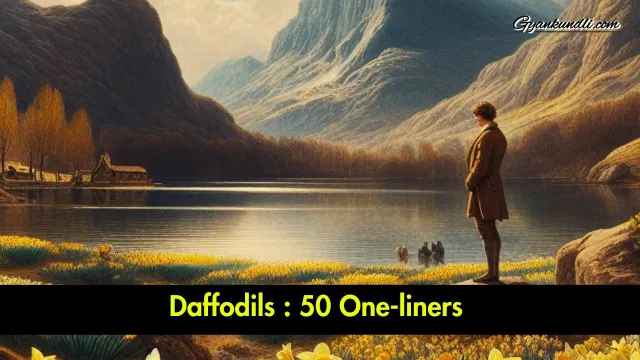William Worsworth’s Daffodils Question Answer
1. What did the poet compare himself to in the first line?
– A: A lonely cloud.
2. What did he see when he looked down from the sky?
– A: A crowd of golden daffodils.
3. Where were the daffodils growing?
– A: Beside the lake, beneath the trees.
4. How were the daffodils moving?
– A: Fluttering and dancing in the breeze.
5. What did the poet compare the daffodils to in the second stanza?
– A: The stars that shine and twinkle on the milky way.
6. How many daffodils did the poet see at a glance?
– A: Ten thousand.
7. How were the daffodils tossing their heads?
– A: In sprightly dance.
8. What else was dancing beside the daffodils?
– A: The waves.
9. How did the daffodils outdo the waves?
– A: In glee.
10. How did the poet feel in the company of the daffodils?
– A: Gay.
11. How long did the poet gaze at the daffodils?
– A: He gazed and gazed, but did not think much.
12. What did the daffodils show to the poet?
– A: Wealth.
13. When did the poet recall the daffodils?
– A: When he lay on his couch in vacant or in pensive mood.
14. What did the daffodils flash upon?
– A: The inward eye of the poet.
15. What did the poet call the inward eye?
– A: The bliss of solitude.
16. How did the poet’s heart feel when he remembered the daffodils?
– A: It filled with pleasure.
17. How did the poet’s heart dance?
– A: With the daffodils.
18. What is the rhyme scheme of the poem?
– A: ABABCC.
19. What is the meter of the poem?
– A: Iambic tetrameter.
20. What is the tone of the poem?
– A: Joyful and reflective.
21. What is the theme of the poem?
– A: The power of nature and memory to inspire and comfort the poet.
22. What is the setting of the poem?
– A: The Lake District in England, where the poet lived for some time.
23. What is the name of the lake that the poet mentions in the poem?
– A: Ullswater.
24. When did the poet write the poem?
– A: In 1804, after revisiting the site of the daffodils with his sister Dorothy.
25. When was the poem first published?
– A: In 1807, in a collection called Poems in Two Volumes.
Read this also : William Wordsworth’s Daffodils : Analysis
26. What is the literary device that the poet uses to compare himself to a cloud?
– A: A simile.
27. What is the literary device that the poet uses to compare the daffodils to stars?
– A: A metaphor.
28. What is the literary device that the poet uses to give the daffodils human qualities, such as dancing and tossing their heads?
– A: Personification.
29. What is the literary device that the poet uses to create a vivid image of the daffodils, such as “golden”, “fluttering”, and “sprightly”?
– A: Imagery.
30. What celestial image is used to emphasize the abundance of daffodils?
– A: They’re compared to the countless stars of the Milky Way, highlighting their vastness and infinite quality.
31. How does the poem connect the beauty of nature to poetic inspiration?
– A: The speaker suggests that being in “such a jocund company” naturally sparks a joyful disposition, inspiring even a poet to feel uplifted.
32. What is the literary device that the poet uses to emphasize the number of daffodils, such as “ten thousand” and “never-ending”?
– A: Hyperbole.
33. What is the literary device that the poet uses to express his feelings, such as “gay” and “pleasure”?
– A: Emotion.
34. How does the poem connect the external experience of nature to internal emotional well-being?
– A: The encounter with the daffodils leaves a lasting impression on the speaker’s inner world, providing him with a source of emotional solace and rejuvenation even in solitude.
35. What is the title of the poem?
– A: Daffodils or I Wandered Lonely as a Cloud.
36. Who is the writer of the poem?
– A: William Wordsworth.
37. What is the genre of the poem?
– A: Lyric poetry.
38. What is the main subject of the poem?
– A: The poet’s encounter with a field of daffodils and its lasting impact on his mood and imagination.
39. What is the main emotion that the poet expresses in the poem?
– A: Happiness.
40. What is the main symbol that the poet uses in the poem?
– A: The daffodils, which represent nature, beauty, and joy.
41. What is the main literary movement that the poet belongs to?
– A: Romanticism.
42. What is the main purpose of the poem?
– A: To celebrate the power of nature and memory to inspire and comfort the poet and the reader.
43. What is the main contrast that the poet creates in the poem?
– A: Between his loneliness and the daffodils’ company, between his pensiveness and the daffodils’ glee, and between his solitude and the daffodils’ crowd.
44. What is the main message that the poet conveys in the poem?
– A: That nature can provide a source of happiness and consolation for the human soul, even in times of isolation or sadness.
45. What specific number intensifies the vastness of the daffodil display?
– A: The speaker estimates seeing “ten thousand,” further enhancing the feeling of immense natural splendor.
46. What words suggest the daffodils’ movement and vitality?
– A: “Fluttering” and “dancing” evoke a sense of lightness, fluidity, and playful energy.
47. How does the line “stretched in never-ending line” contribute to the description?
– A: It reinforces the overwhelming number of daffodils, creating a sense of endless beauty and continuity.
48. What verbs portray the daffodils’ lively movements?
– A: “Tossing” and “dancing” suggest carefree swaying and vibrant energy, mirroring the playful movement of the wind.
49. What role does the poem’s simple diction play in conveying the speaker’s emotions?
– A: The use of straightforward language without elaborate metaphors mirrors the speaker’s genuine and direct response to the natural world, emphasizing the raw impact of beauty on his emotions.
50. Does the poem imply that happiness found in nature is superior to human connection?
– A: While the daffodils offer solace and joy, the poem ultimately celebrates the interplay between external experience and internal reflection. Human connections can also contribute to inner fulfillment, alongside the beauty of nature.
Discover more from Gyankundli
Subscribe to get the latest posts sent to your email.














1 thought on “Daffodils Question Answer : 50 One-liners”